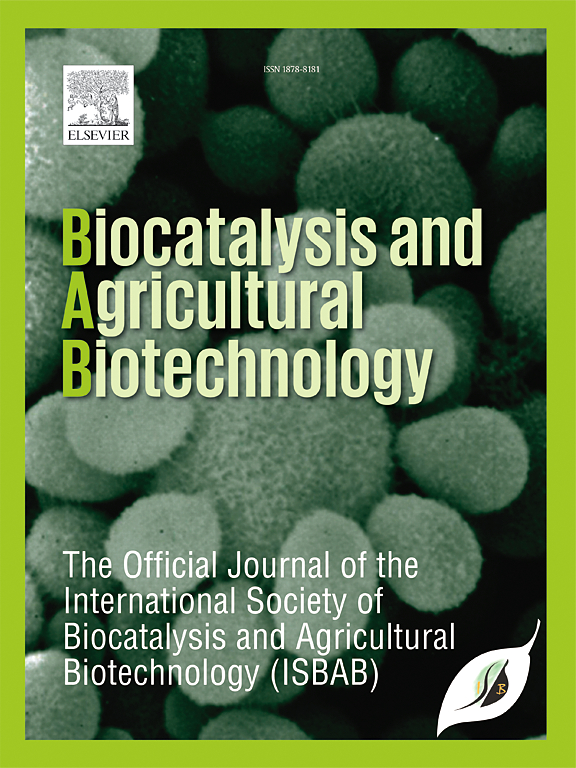褐藻等chrysis galbana生物量和富岩藻黄素类胡萝卜素生产的顺序优化
IF 3.4
Q2 BIOTECHNOLOGY & APPLIED MICROBIOLOGY
引用次数: 0
摘要
微藻是高价值生物活性化合物的有希望的来源,为合成化学品提供可再生、低废物和环保的替代品。本研究重点研究了优化培养条件,以提高其生物量和类胡萝卜素产量,特别是提高岩藻黄质,一种具有多种生物活性的强抗氧化剂。采用单因素单次筛选(OFAT)和响应面法(RSM)相结合的顺序优化策略,对关键理化变量进行识别和细化。在2.75 mM硝酸盐、0.32 mM磷酸盐和23 μE m−2 s−1光强条件下生物量产量最高,而在2.43 mM硝酸盐、0.28 mM磷酸盐和28 μE m−2 s−1光强条件下,总类胡萝卜素和岩藻黄素产量最高。优化条件下,生物量达到1.40±0.05 g L−1(体积生产力为0.05 g L−1 d−1),类胡萝卜素总量增加到98.67±1.43 mg g−1 (4.34 mg L−1 d−1),岩藻黄质含量增加到31.36±1.55 mg g−1 (1.38 mg L−1 d−1)。与未优化条件相比,这些值分别增加了4.83、4.47和4.24倍。结果表明,在优化的条件下,黄藻是大规模生产岩藻黄质和其他类胡萝卜素的可行和可持续的途径。这项工作支持了将基于I. galbana的系统整合到针对功能食品、营养药品和制药应用的生物技术管道中的潜力。本文章由计算机程序翻译,如有差异,请以英文原文为准。
Sequential optimization for biomass and fucoxanthin enriched carotenoid production of Isochrysis galbana
Microalgae are promising sources of high-value bioactive compounds, offering renewable, low-waste, and environmentally friendly alternatives to synthetic chemicals. This study focuses on optimizing the cultivation conditions of Isochrysis galbana to enhance biomass and carotenoid production, with particular emphasis on enhancing fucoxanthin, a potent antioxidant with diverse biological activities. A sequential optimization strategy combining one-factor-at-a-time (OFAT) screening and response surface methodology (RSM) was employed to identify and refine key physicochemical variables. Optimal conditions for biomass production were 2.75 mM nitrate, 0.32 mM phosphate and 23 μE m−2 s−1 light intensity, whereas total carotenoids and fucoxanthin yields were maximized at 2.43 mM nitrate, 0.28 mM phosphate, and 28 μE m−2 s−1. Under optimized conditions, biomass reached 1.40 ± 0.05 g L−1 (volumetric productivity: 0.05 g L−1 d−1), total carotenoids increased to 98.67 ± 1.43 mg g−1 (4.34 mg L−1 d−1), and fucoxanthin content was enhanced to 31.36 ± 1.55 mg g−1 (1.38 mg L−1 d−1). These values represent 4.83, 4.47, and 4.24-fold increases, respectively, compared to the unoptimized conditions. The results demonstrate that I. galbana cultivation under optimized conditions is a viable and sustainable approach for the large-scale production of fucoxanthin and other carotenoids. This work supports the potential integration of I. galbana-based systems into biotechnological pipelines targeting functional foods, nutraceuticals, and pharmaceutical applications.
求助全文
通过发布文献求助,成功后即可免费获取论文全文。
去求助
来源期刊

Biocatalysis and agricultural biotechnology
Agricultural and Biological Sciences-Agronomy and Crop Science
CiteScore
7.70
自引率
2.50%
发文量
308
审稿时长
48 days
期刊介绍:
Biocatalysis and Agricultural Biotechnology is the official journal of the International Society of Biocatalysis and Agricultural Biotechnology (ISBAB). The journal publishes high quality articles especially in the science and technology of biocatalysis, bioprocesses, agricultural biotechnology, biomedical biotechnology, and, if appropriate, from other related areas of biotechnology. The journal will publish peer-reviewed basic and applied research papers, authoritative reviews, and feature articles. The scope of the journal encompasses the research, industrial, and commercial aspects of biotechnology, including the areas of: biocatalysis; bioprocesses; food and agriculture; genetic engineering; molecular biology; healthcare and pharmaceuticals; biofuels; genomics; nanotechnology; environment and biodiversity; and bioremediation.
 求助内容:
求助内容: 应助结果提醒方式:
应助结果提醒方式:


